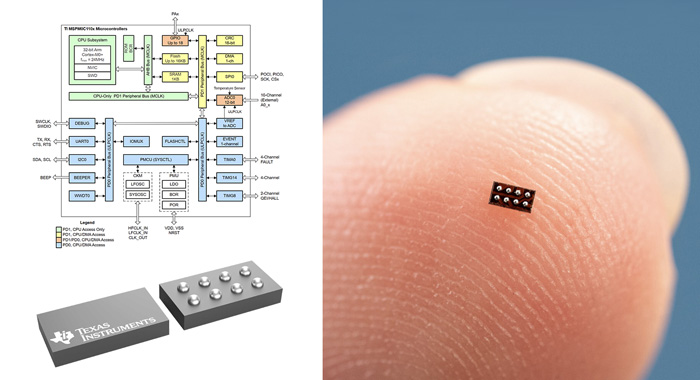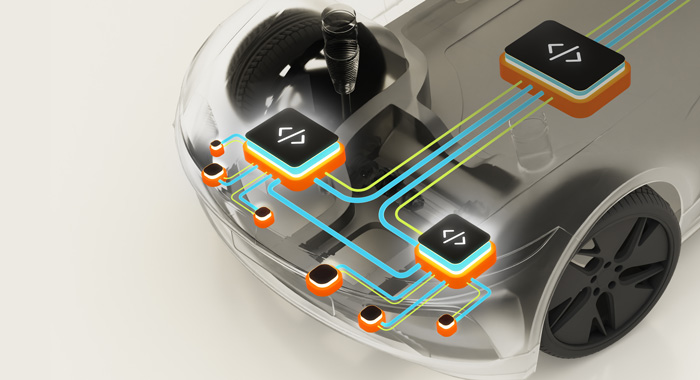With the rapid development of science and technology, the innovation of microcontrollers (MCUs) is constantly driving the miniaturization and efficiency of electronic devices. Recently, Texas Instruments (TI) and NXP respectively launched breakthrough MCU products, further consolidating their leading position in the semiconductor industry.
TI released the world's smallest MCU, the MSPM0C1104. With a wafer chip-scale package (WCSP) of only 1.38 square millimeters, which is 38% smaller than existing similar competitors. It provides greater flexibility in the design of medical wearable devices and personal electronic products. NXP launched the new S32K5 series of automotive MCUs, the automotive industry's first 16nm FinFET MCU with embedded magnetic RAM (MRAM), designed to support the development of software-defined vehicle (SDV) architecture. The launch of these two products highlights cutting-edge breakthroughs in MCU technology but also lays a solid foundation for the innovative development of future smart devices.
TI Launches Ultra-small MCU, The MSPM0C1104
Texas Instruments recently launched the MSPM0C1104, the world's smallest MCU to date, further expanding the Arm® Cortex®-M0+ MSPM0 MCU product portfolio. This MCU features a wafer chip scale package (WCSP) and measures only 1.38mm2. It is 38% smaller than that of a similar competitor on the market.
This new product brings a breakthrough for compact applications such as medical wearable devices and personal electronics. "In ultra-small systems such as earbuds and medical probes, board space is a scarce and valuable resource," said Vinay Agarwal, vice president and general manager of Texas Instruments' MSP microcontroller division. "Thanks to this world's smallest MCU, our MSPM0 MCU portfolio will bring unlimited possibilities, making our daily life experience more intelligent and connected."
Many consumers hope that daily electronic devices such as electric toothbrushes and styluses can be made smaller, cheaper, and have more functions. To reduce the size of the product and increase the functions while maintaining the board space, smaller integrated components are necessary.

Source from Internet
The MSPM0C1104 can help designers optimize board space while ensuring performance. It can enhance the sensing and control capabilities of embedded systems, and reduce costs, complexity, and design time.
Texas Instruments MSPM0 MCU portfolio includes more than 100 cost-effective MCUs that provide scalable on-chip analog peripheral configurations and multiple computing options, thereby enhancing the sensing and control capabilities of embedded designs. This series of devices has been unveiled at the International Embedded World in Nuremberg, Germany.
The MSPM0 MCUs offer pin-to-pin compatible packaging options and feature sets to meet the memory, analog, and computing power needs of personal electronics, and industrial and automotive applications. In addition, the portfolio offers a variety of small package options to help optimize board size and streamline the bill of materials. The inclusion of the MSPM0C1104 in the MSPM0 MCU portfolio combines scalability, cost optimization, and ease of use to shorten time to market.
In addition, TI's comprehensive ecosystem provides further support, including software development kits optimized for all MSPM0 MCUs, hardware development kits for rapid prototyping, reference designs, and subsystems as code examples for common MCU functions. With TI's Zero Code Studio tool, users can configure, develop, and run MCU applications in just minutes without writing any code. Engineers can use this ecosystem to expand designs and rewrite code without making major changes to hardware or software. In addition, to meet future needs, TI continues to invest in improving internal manufacturing capabilities, which also supports the MSPM0 MCU product portfolio.
The MSPM0C1104 MCU is available for pre-sale on TI.com, and the MSPM0C1104 LaunchPad™ development kit is available on TI.com.
NXP S32K5 series Automotive MCU with Embedded MRAM Memory
NXP Semiconductors has released a new S32K5 series of automotive microcontrollers. This is the automotive industry's first 16nm FinFET MCU with embedded MRAM. The series will expand the NXP CoreRide platform with pre-integrated partitioning and electrification system solutions to achieve scalable software-defined vehicle (SDV) architecture.

Source from Internet
Automakers are gradually adopting regional control architectures to distribute and integrate electronic control unit (ECU) functions in various ways. The foundation of these regional control solutions is a new generation of MCU architectures that integrate real-time performance, low-latency deterministic communication, and innovative isolation capabilities.
NXP Semiconductors is a trusted partner for innovative solutions in the automotive market. The new series of MCUs uses Arm® Cortex® CPU cores, running at up to 800MHz, and provides energy-efficient application performance through a 16nm FinFET process. The S32K5 integrates an Ethernet switch core shared with NXP's S32N automotive processors, providing a mature network solution that simplifies network design and enables software reuse.
The S32K5 is equipped with a dedicated eIQ® Neutron neural processing unit (NPU), NXP's scalable machine learning accelerator that enables machine learning algorithms to perform energy-efficient real-time processing of vehicle edge sensor data. It can be used to offload critical workloads, including network communication conversion, information security, and digital signal processing.

Source from Internet
The S32K5 integrates a software-defined, hardware-enhanced isolation architecture to help automakers achieve functional safety and information security partitioning, ensuring that safety applications up to ASIL-D level can be integrated without affecting the functional safety or performance of the overall system.
In addition, the on-chip high-performance MRAM can shorten the time of ECU program burning in the factory and the time of remote OTA program update, and the writing speed is more than 15 times faster than embedded Flash. Combined with NXP's new security accelerator, including post-quantum encryption (PQC) function, S32K5 enables automakers to deploy new features safely and reliably throughout the life cycle of the car, benefiting automakers and users.
S32K5 will begin to provide samples to major customers in the third quarter of 2025.
Conclusion
With the accelerated arrival of the era of the Internet of Things and smart cars, MCU, as the core hub connecting the physical world and the digital world, is undergoing a dual revolution from "miniaturization" to "intelligence". TI redefines the space limit with MSPM0C1104, allowing medical wearable devices and consumer electronics to balance performance in the process of miniaturization.NXP provides a high-efficiency and high-responsive computing power base for software-defined cars through the combination of MRAM and NPU in the S32K5 series. The innovations of the two seem to have different paths, but through breakthroughs in underlying technologies, terminal devices are driven to evolve towards a lighter and more autonomous future. This technological wave led by semiconductor giants may be the key to opening the next generation of smart hardware ecology.
Sourcing Microcontrollers and other electronic components at Hard Find Electronics Tech Limited to get a competitive quote.